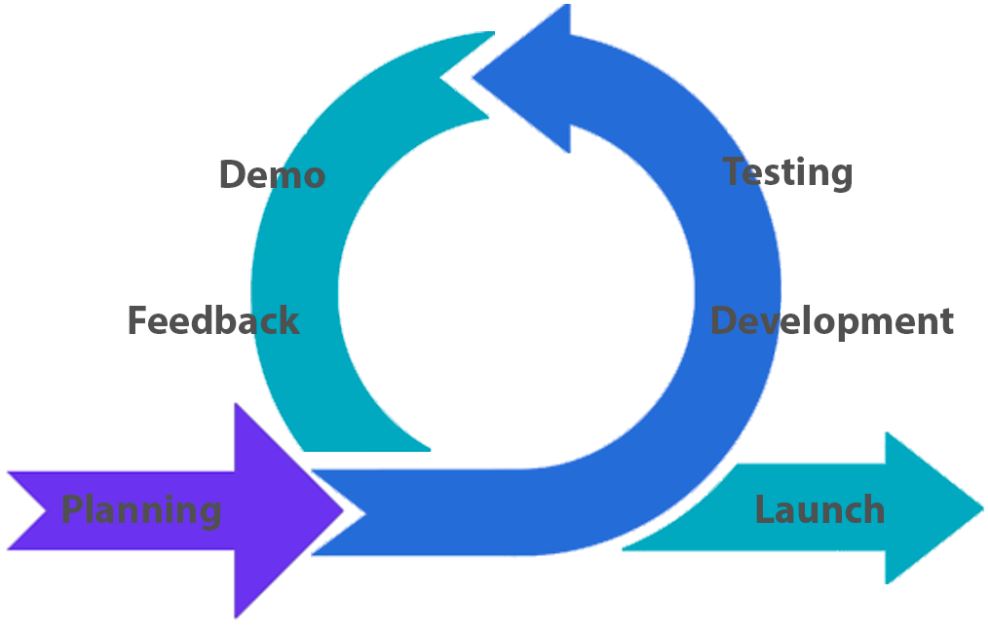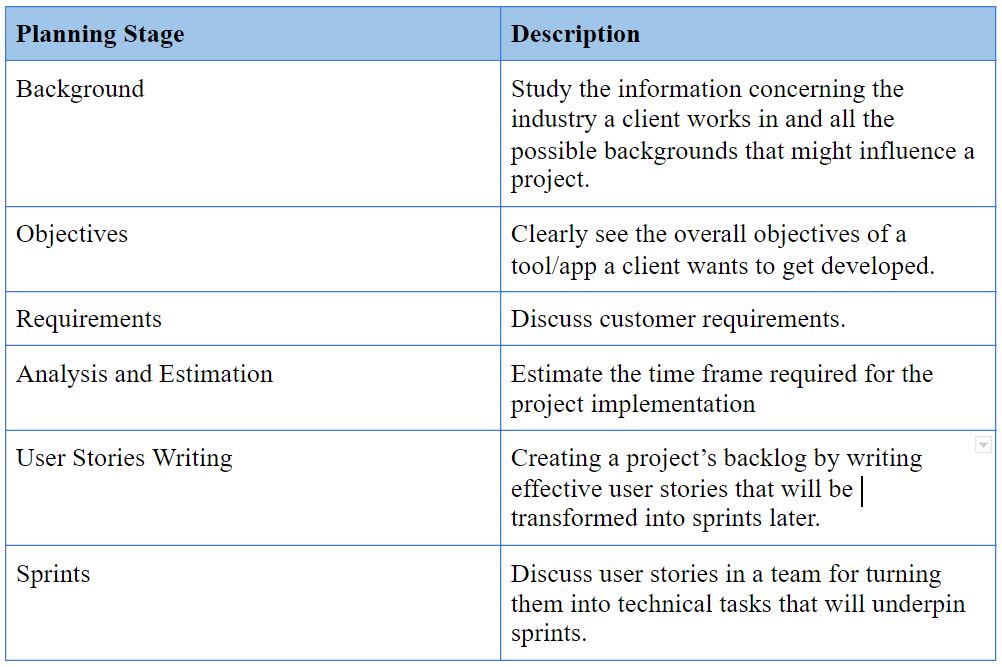Agile software development methodology is a way to adjust the development process to ever-changing global market tendencies.
Flexibility, transparency, predictability, iterations, and focus on customer requirements lower the software development risks and help get a usable portion of a product within a short time period.
Let's see which stages are inherent to the Agile software development life cycle.
Software Development Lifecycle Explained
After the negotiations between sales reps and customers are finished & the contract is signed, they're about to go through the next steps:

1. Planning
The stage where there is successful communication between technical partners and customers is a must. Their common goal is to find out what exactly the end-user needs, drawing up a list of the requirements, and sorting out the priorities to offer a solution that will work out.
Thereafter, it's time to decide on the appropriate technology that type of product requires and prepare the specification and other project’s documentation needed.
A technical partner contributes to shaping the product idea (if required), participates in product discovery, advises on mockups, and creates a road map for further development.

Then comes user story mapping: a visual technique that keeps focus on the functionality the product should have to solve the specific end-user problems. So, the maximum attention is required when typing user stories as they literally define the future functionality. The ideal option is to involve customers and/ or end-users in this process to form a deeper understanding of their demands and needs.
The last thing to do in the planning stage is to break the entire development process into smaller stages called sprints. This is one of the main principles and benefits of the Agile development life cycle, as it helps customers get the result right away.

Last but not least, remember that Agile teams are flexible, so if your request is beyond the "standard package", it's totally ok as nobody canceled personal approach and customization.
2. Development
The development stage is the time to use the expertise of technical partners for turning the mockups, wireframes, and prototypes into a superb product that will bring money.
2.1 Architecture
The main objective of this stage is to define both front and back end application architecture. Well-designed software architecture plays a decisive role when thinking about further development and support. Why? The similar happens with the buildings. Imagine two houses: one has a clear and stable architecture, and another is poorly designed. What house will be easier to modify and run? Of course, the one with a stable, solid construction, and clear structure that obeys all the laws of logic.
2.2 Development: sprints
Sprints are theiterations of a development cycle. Usually, at the end of each sprint customers already get tangible results. In this way, they and what is more important, end-users can assess the part of the functionality to give valuable feedback and/or amend the process right away without losing precious time or put much more time and effort to fix errors than at an early stage.
A fixed time period is allocated to work on each of the sprints provided that the number and complexity of tasks may vary. This is usually discussed during the “Planning” stage so that a customer could have a precise idea of how long each sprint and full project implementation will take and adjust something before the next sprint.

3. QA
Before every product’s release, a QA is a must to provide a product of a high quality to customers. Quality assurance specialists ensure the product works as it has to, reporting the bugs and tracking the progress of their fixing. They not only check the product itself but verify the functionality corresponds to the initial requirements.

4. Release
In addition to the everyday reports and board with tasks statuses (usually, “Backlog”, “In Progress”, “Testing”, “Done”, “In review” but may vary from project to project), customers get the regular updates after every sprint, where they monitor the progress and agree on the next sprint’s tasks (if some changes are required, the technical team will add them to the requirements immediately to improve the product).
The great Agile advantage is the possibility to repeat the “Planning” stage after each release that gives a customer the maximum freedom of product creation. Continuous integration & delivery (CI/CD) helps understand the product’s weaknesses right away so that they could be fixed before becoming irreversible.

Software development phases iterate until the project is done. After all the sprints are completed and the customer is satisfied, the final version of a product is presented to a customer, and the further actions are discussed.
5. Support
Monitoring the project’s characteristics in real conditions and users’ interaction with the product are the main objectives of this stage, as it can significantly increase the quality of the product. Based on that data, the development team could make any changes or improvements required without influencing the general performance.
Although post-release maintenance is often determined by the customer at the “Planning” stage, a technical team is flexible and stays motivated to upgrade the product per request.
Benefits of Agile Approach in Software Development
When communication between a company and a customer becomes the top priority, Agile methodology comes to the fore to meet customer’s demands halfway. Agile reflects the natural workflow of the software development teams, no surprise it incorporates the best experience of building web and mobile apps.
The first thing coming to mind when thinking of the Agile software development steps is an iteration—a single development cycle allowing a customer to get a working product quicker in comparison to Waterfall model, for example.
But what are the other main benefits of the methodology that is at the core of the Agile software life cycle?
Agile is predictable.If a customer gets regular product’s releases and 24/7 access to the test server, the probability to get a screwed-up product is approaching zero.
Agile is transparent.Except for the daily reports, a customer accesses the results of any tasks completed by the technical team at any time. Always keeping in touch with the technical partner means less concerns about the process and/or product quality.
Agile is client-oriented.Agilealways leaves an opportunity to revise the requirements to a product before each new sprint. It means that customers stay involved in the process of development, as effective communication throughout the project is the key to success.
Agile contributes to better team engagement.At each stage, the designers, devs, PM, etc. (depending on the project type) search for the solution being the part of one team. Instead of fragmenting the workload and dividing it between different people, all the solutions are taken together, making use of the skills and experience of each team member.
Wrapping Up!
Agile Software Development is the mantra of success for developers now! The best software developers have mastered the art and can build the best product for you.



